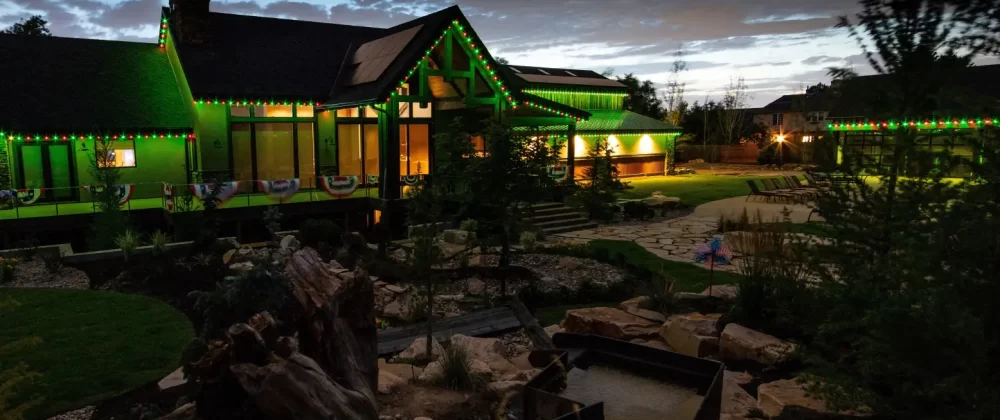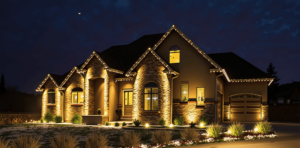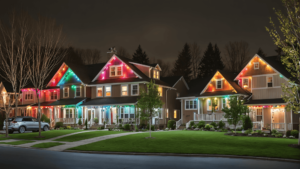When it comes to illuminating your home’s exterior, choosing the right lighting solution is essential for enhancing its curb appeal, increasing security, and creating a welcoming ambiance. Two popular options for outdoor lighting are Trimlight systems and traditional outdoor lighting fixtures.
Each option offers its own set of benefits and considerations, making it crucial for homeowners to weigh their options carefully.
In this guide, we’ll compare the trimlight systems and traditional outdoor lighting to help you determine which option is right for your home.
Understanding Trimlight Systems:
Trimlight systems utilize advanced LED technology and innovative design to provide customizable and programmable lighting options for homes. Key features of Trimlight systems include:
- Customization: Trimlight systems offer a wide range of customization options, allowing homeowners to select color schemes, lighting patterns, and special effects to suit their preferences.
- Programmability: With Trimlight systems, homeowners can program lighting schedules and sequences to create dynamic and eye-catching displays for various occasions and events.
- Integration: Trimlight systems can be seamlessly integrated into existing home automation systems, allowing for convenient control and management of lighting settings via smartphones, tablets, or voice commands.
Exploring Traditional Outdoor Lighting:
Traditional outdoor lighting fixtures include a variety of options such as floodlights, spotlights, sconces, and pathway lights. Key features of traditional outdoor lighting include:
- Versatility: Traditional outdoor lighting fixtures come in various styles, sizes, and finishes, making them suitable for different architectural styles and design preferences.
- Functionality: Traditional outdoor lighting fixtures provide reliable illumination for key areas of the home, such as entryways, pathways, and outdoor living spaces, enhancing safety and visibility.
- Affordability: Compared to Trimlight systems, traditional outdoor lighting fixtures are often more affordable upfront, making them a budget-friendly option for homeowners looking to improve their home’s exterior lighting.
Comparing Cost and Installation:
- Cost: When its time to consider Trimlight Austin cost and traditional outdoor lighting fixtures, it’s essential to consider both upfront expenses and long-term costs. While Trimlight systems may have a higher upfront cost due to their advanced technology and customization options, they offer potential long-term savings in energy efficiency and maintenance.
- Installation: Trimlight systems typically require professional installation due to their complexity and wiring requirements. On the other hand, homeowners can often install traditional outdoor lighting fixtures with minimal professional assistance, reducing installation costs.
Considering Aesthetic Appeal and Design:
- Aesthetic Appeal: Trimlight systems are known for their sleek and modern design, offering a seamless and integrated lighting solution that enhances the architectural features of the home. Traditional outdoor lighting fixtures, meanwhile, provide a classic and timeless look that complements a variety of home styles.
- Design Flexibility: While Trimlight systems offer extensive customization options, traditional outdoor lighting fixtures provide flexibility in terms of placement and design, allowing homeowners to mix and match fixtures to create a unique and personalized lighting scheme.
Evaluating Maintenance and Longevity:
- Maintenance: Trimlight systems require minimal maintenance once installed, thanks to their durable construction and energy-efficient LED technology. Traditional outdoor lighting fixtures may require frequent maintenance, including bulb replacement, cleaning, and repairs.
- Longevity: Trimlight systems are designed to be long-lasting and durable, with LED bulbs that have a lifespan of up to 50,000 hours or more. Traditional outdoor lighting fixtures may have a shorter lifespan and may need to be replaced or upgraded over time.
Assessing Energy Efficiency and Environmental Impact:
- Energy Efficiency: Trimlight systems are highly energy-efficient, consuming less power than traditional outdoor lighting fixtures while providing superior illumination and control options. This can result in lower energy bills and reduced environmental impact over time.
- Environmental Impact: LED technology used in Trimlight systems is environmentally friendly, producing less heat and containing no harmful chemicals such as mercury. Additionally, Trimlight systems can be programmed to reduce energy consumption during off-peak hours, further minimizing their environmental footprint.
Considering Security and Safety Benefits:
- Security: Both Trimlight systems and traditional outdoor lighting fixtures can enhance home security by illuminating key areas such as entryways, pathways, and dark corners. Trimlight systems offer the added benefit of programmable lighting schedules and motion-activated sensors for enhanced security.
- Safety: Adequate outdoor lighting is essential for preventing trips, slips, and falls, especially in poorly lit areas around the home. Trimlight systems and traditional outdoor lighting fixtures can improve safety by providing visibility and illumination where needed.
Making the Right Choice for Your Home:
Ultimately, the decision between Trimlight systems and traditional outdoor lighting fixtures depends on your specific needs, preferences, and budget.
Consider factors such as customization options, trimlight cost in Austin, installation requirements, aesthetic appeal, maintenance, energy efficiency, security benefits, and environmental impact when making your decision. Whether you opt for the advanced technology and customization of Trimlight systems or the classic simplicity of traditional outdoor lighting fixtures, both options can enhance the beauty, functionality, and safety of your home’s exterior.
You May Also Like: Tips for Budgeting and Financing Your Trimlight Installation in Austin




